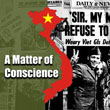Original Story Appeared in the November 29, 2003 issue of the Toledo Blade newspaper, Toledo, Ohio
Another vet recalls Vietnam atrocities
MICHAEL D. SALLAH AND MITCH WEISS
Block News Alliance
NOV 29, 2003
9:00 PM
Dennis Stout was a soldier caught between the ethics of his job and surviving in an unforgiving Army.
The Series
For a complete presentation of all four installments described below, including audio interviews, photographs and graphics, visit the Toledo Blade’s index to its series.
Day One: : The series opens with a report on Tiger Force’s arrival in the Central Highlands and how the atrocities began.
Day Two : The cover-up began before the killing ended. And by the time the Army finished its investigation — which was sent to the Pentagon and the White House — no one was ever charged. A justice system that promised to prosecute war criminals ended up protecting them.
Day Three : Thirty-six years later, the reminders of Tiger Force’s rampage through Quang Ngai province are everywhere, and the stories of the atrocities are still told by the Vietnamese villagers. To this day, the shooting deaths evoke anger in those who survived the attacks — with some calling for former American soldiers to be prosecuted.
Day Four : Many former Tiger Force soldiers say they’re still haunted by their memories of the killings and mutilations of prisoners and unarmed villagers in 1967. Ten have been diagnosed with post-traumatic stress disorder. Some have turned to alcohol and drugs to ease the pain.
As the people huddled — some crying-the soldiers moved the villagers into small groups and led them to the edge of the field.
Then came the gun shots, with bodies falling.
“They just killed them — mothers, with little kids and old people,” he recalled.
Though he wrote for an Army newspaper, he said he was banned from reporting about the killings that July day in 1967.
It would be 36 years before the American public would learn of the elite unit known as Tiger Force, and its unprovoked attacks on Vietnamese villagers.
The platoon’s war crimes were revealed in a recent series, “Buried Secrets, Brutal Truths,” by The Blade in Toledo, Ohio, which described the slaughter of unarmed civilians by the soldiers between May and November 1967.
The Army investigated the case for 41/2 years, substantiating 20 war crimes involving 18 soldiers. But no one was charged.
As a public information officer who moved among fighting units, Stout said he watched the platoon soldiers routinely kill men, women, and children, but was unable to stop the brutality.
“I knew what they were doing was wrong — this unit was out of control,” said the former sergeant, who wrote for the Screaming Eagle, the newspaper of the 1st Battalion/327th Infantry.” There was no reason for what they did. No reason at all.”
It wasn’t just Tiger Force.
During his five months as a press officer, he said, soldiers from the 101st Airborne Division — the larger unit that included Tiger Force -were committing atrocities.
He watched 22 paratroopers rape and execute a woman, he said, and a medic pump swamp water into the heart of a prisoner before he was fatally shot by soldiers.
Stout said he told a master sergeant, but was ordered to forget the killings. He confided to a chaplain, but was warned to keep quiet.
After leaving the Army in 1969, he complained to Army officials who promised to investigate.
But for three decades, the Pentagon refused to say what happened to his case — and the detailed records he provided to agents.
“I just thought it disappeared,” he said.
In fact, the Army sent two letters to Stout in 1997, saying officials were “unable to locate” records of his complaints.
But documents at the National Archives tell a different story.
Records show that the Army conducted an investigation for two years of his complaints beginning on Dec. 16, 1969.
Known as the “Stout Allegation,” the inquiry focused on eight specific atrocities passed on to agents by Stout, including the Tiger Force executions of villagers in the field.
It can’t be determined if anyone was charged because hundreds of documents including sworn witness statements are missing from the case, according to senior archivists.
It was during Stout’s stint as an Army journalist in the Song Ve Valley that he began to observe mass executions, he said.
The unit leading the charge was Tiger Force, he said.
“They just shot everybody,” said Stout, 58, now a building contractor who lives in Phoenix. “There were no civilians they ever let go. They killed everybody they could find.”
He said his job was to write positive stories about soldiers in battle. But after witnessing assaults on villagers in the Song Ve, he said his faith was shaken in the military. “They just lined people up and shot them.”
It was the beginning of his own struggles with memories of soldiers shooting civilians that persist today, he said.
Records show he arrived in Vietnam in September 1966, and was assigned to Company B of the 1st Battalion/327th Infantry.
After the Illinois native was grazed by a bullet during a fire fight in May, 1967, he was appointed the battalion’s press officer.
That same month, the battalion was sent to the Quang Ngai Province to help the U.S. military control the contested Central Highlands. Part of the unit’s mission was to move thousands of civilians to relocation centers.
After arriving, the battalion — including Tiger Force — moved to the Song Ve Valley, a remote, fertile basin in the center of the province.
The goal of the military was to stop the 5,000 inhabitants from growing rice — food that could feed the enemy. But with deep ties to the land, many villagers refused to leave. That’s when Tiger Force members joined other battalion soldiers in what became a grisly routine: Shooting villagers who stayed in their hamlets.
Stout said commanders were counting the executed civilians as enemy soldiers to help boost “body count.”
In Vietnam, the measure of success was the number of enemy soldiers killed — not the taking of land, say military historians.
Stout said in July he spotted a sign posted in a command center in the valley with a tally of the dead enemy soldiers: 600. But the numbers of weapons seized totaled only 11. “Most of the dead people were civilians.”
He said he stood across a field and witnessed the execution of 35 unarmed villagers by Tiger Force soldiers. “They took five people at a time to different parts of the field and just shot them. I’ll never forget it as long as I live. I wake up at night sometimes and I still see those women and children.”
He was honorably discharged from the Army in February 1969, and enrolled in Arizona State University.
That year, the story of the My Lai Massacre — the slaughter of 500 villagers by the Army’s 11th Brigade — was revealed by reporter Seymour Hersh. After reading about the attack, Stout contacted a lawyer, Gerald Pollock of Phoenix.
“I needed to tell people that My Lai was not an isolated case,” he said.
Pollock said he remembered meeting with Stout. “He was obviously nervous, but he wanted to tell people about what he saw.”
In December 1969, Stout and his lawyer met with representatives of the Army’s criminal investigation command.
Stout said he remembered filing eight complaints. including the executions of the villagers in the field by Tiger Force soldiers.
During two additional meetings, Stout said he provided Army investigators with the names of suspects, locations of war crimes, and identification cards he took from dead villagers. He said he also turned over the names of the sergeant major and chaplain to whom he initially complained.
“I gave these people names and locations within five meters of where the killings occurred,” he said. “My stuff was so nailed down. I was so specific, I knew they would have to take action.”
However, he said in 1970, he received a letter from the Army stating the investigation could not proceed, because agents were unable to go behind enemy lines to talk to witnesses.
But that was not the case.
Unknown to Stout, Army agents were interrogating dozens of witnesses — more than 100 in two years.
Army officials say they are now conducting a review of the Tiger Force investigation, including comparing the evidence gathered three decades ago by Army agents with The Blade’s findings.


